巨坑系列:Java Bean 转 Map 的那些坑
Posted 明明如月学长
tags:
篇首语:本文由小常识网(cha138.com)小编为大家整理,主要介绍了巨坑系列:Java Bean 转 Map 的那些坑相关的知识,希望对你有一定的参考价值。
一、背景
有些业务场景下需要将 Java Bean 转成 Map 再使用。

本以为很简单场景,但是坑很多。
二、那些坑
2.0 测试对象
import lombok.Data;
import java.util.Date;
@Data
public class MockObject extends MockParent
private Integer aInteger;
private Long aLong;
private Double aDouble;
private Date aDate;
父类
import lombok.Data;
@Data
public class MockParent
private Long parent;
2.1 JSON 反序列化了类型丢失
2.1.1 问题复现
将 Java Bean 转 Map 最常见的手段就是使用 JSON 框架,如 fastjson 、 gson、jackson 等。
但使用 JSON 将 Java Bean 转 Map 会导致部分数据类型丢失。
如使用 fastjson ,当属性为 Long 类型但数字小于 Integer 最大值时,反序列成 Map 之后,将变为 Integer 类型。
maven 依赖:
<!-- https://mvnrepository.com/artifact/com.alibaba/fastjson -->
<dependency>
<groupId>com.alibaba</groupId>
<artifactId>fastjson</artifactId>
<version>2.0.8</version>
</dependency>
示例代码:
import com.alibaba.fastjson.JSON;
import com.alibaba.fastjson.TypeReference;
import java.util.Date;
import java.util.Map;
public class JsonDemo
public static void main(String[] args)
MockObject mockObject = new MockObject();
mockObject.setAInteger(1);
mockObject.setALong(2L);
mockObject.setADate(new Date());
mockObject.setADouble(3.4D);
mockObject.setParent(3L);
String json = JSON.toJSONString(mockObject);
Map<String,Object> map = JSON.parseObject(json, new TypeReference<Map<String,Object>>());
System.out.println(map);
结果打印:
“parent”:3,“ADouble”:3.4,“ALong”:2,“AInteger”:1,“ADate”:1657299916477
调试截图:
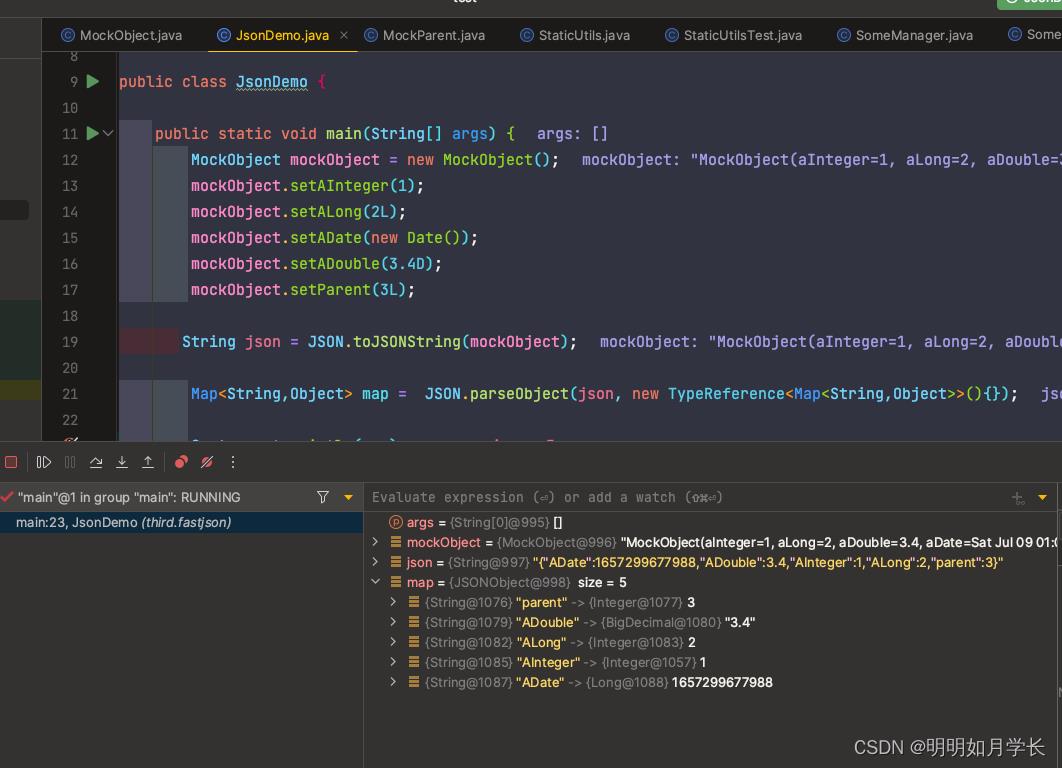
通过 Java Visualizer 插件进行可视化查看:
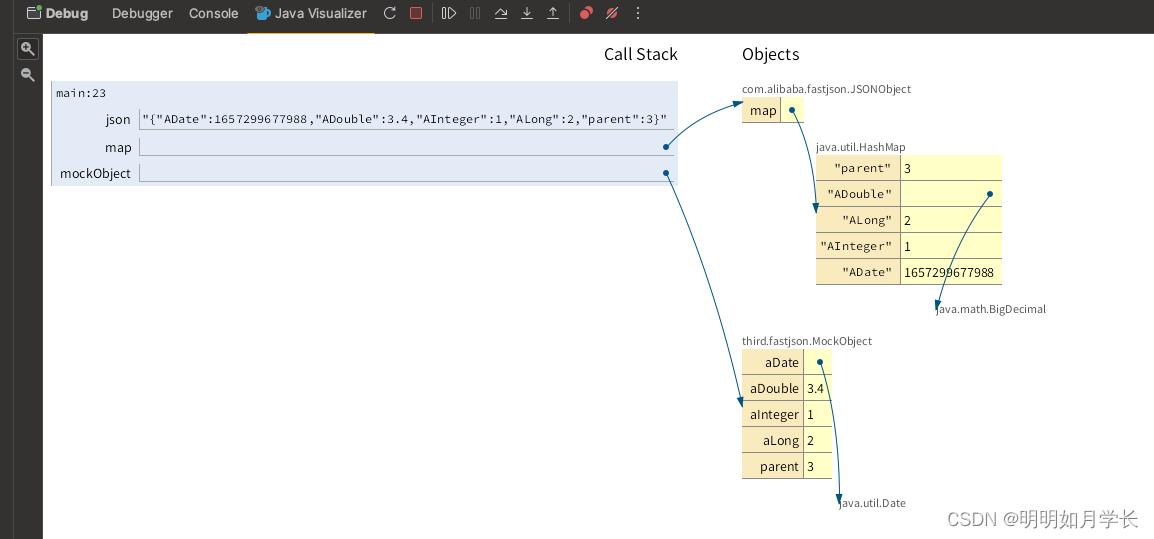
2.2.2 问题描述
存在两个问题
(1) 通过 fastjson 将 Java Bean 转为 Map ,类型会发生转变。
如 Long 变成 Integer ,Date 变成 Long, Double 变成 Decimal 类型等。
(2)在某些场景下,Map 的 key 并非和属性名完全对应,像是通过 get set 方法“推断”出来的属性名。
2.2 BeanMap 转换属性名错误
2.2.1 commons-beanutils 的 BeanMap
maven 版本:
<!-- https://mvnrepository.com/artifact/commons-beanutils/commons-beanutils -->
<dependency>
<groupId>commons-beanutils</groupId>
<artifactId>commons-beanutils</artifactId>
<version>1.9.4</version>
</dependency>
代码示例:
import org.apache.commons.beanutils.BeanMap;
import third.fastjson.MockObject;
import java.util.Date;
public class BeanUtilsDemo
public static void main(String[] args)
MockObject mockObject = new MockObject();
mockObject.setAInteger(1);
mockObject.setALong(2L);
mockObject.setADate(new Date());
mockObject.setADouble(3.4D);
mockObject.setParent(3L);
BeanMap beanMap = new BeanMap(mockObject);
System.out.println(beanMap);
调试截图:

存在和 cglib 一样的问题,虽然类型没问题但是属性名还是不对。
原因分析:
/**
* Constructs a new <code>BeanMap</code> that operates on the
* specified bean. If the given bean is <code>null</code>, then
* this map will be empty.
*
* @param bean the bean for this map to operate on
*/
public BeanMap(final Object bean)
this.bean = bean;
initialise();
关键代码:
private void initialise()
if(getBean() == null)
return;
final Class<? extends Object> beanClass = getBean().getClass();
try
//BeanInfo beanInfo = Introspector.getBeanInfo( bean, null );
final BeanInfo beanInfo = Introspector.getBeanInfo( beanClass );
final PropertyDescriptor[] propertyDescriptors = beanInfo.getPropertyDescriptors();
if ( propertyDescriptors != null )
for (final PropertyDescriptor propertyDescriptor : propertyDescriptors)
if ( propertyDescriptor != null )
final String name = propertyDescriptor.getName();
final Method readMethod = propertyDescriptor.getReadMethod();
final Method writeMethod = propertyDescriptor.getWriteMethod();
final Class<? extends Object> aType = propertyDescriptor.getPropertyType();
if ( readMethod != null )
readMethods.put( name, readMethod );
if ( writeMethod != null )
writeMethods.put( name, writeMethod );
types.put( name, aType );
catch ( final IntrospectionException e )
logWarn( e );
调试一下就会发现,问题出在 BeanInfo 里面 PropertyDescriptor 的 name 不正确。
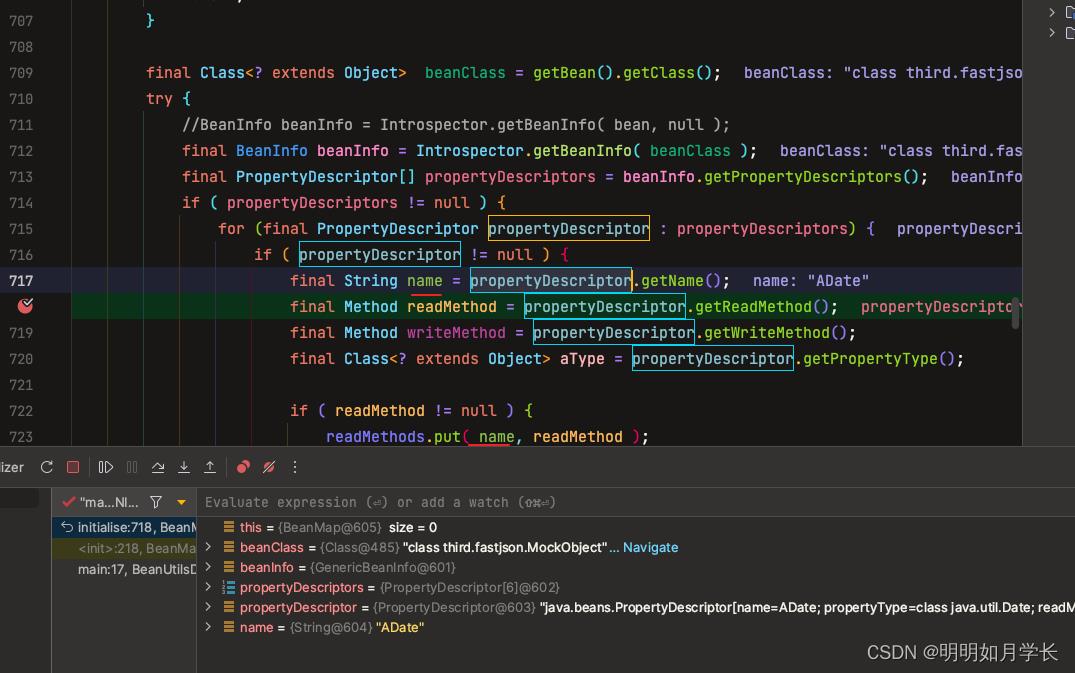
经过分析会发现
java.beans.Introspector#getTargetPropertyInfo 方法是字段解析的关键
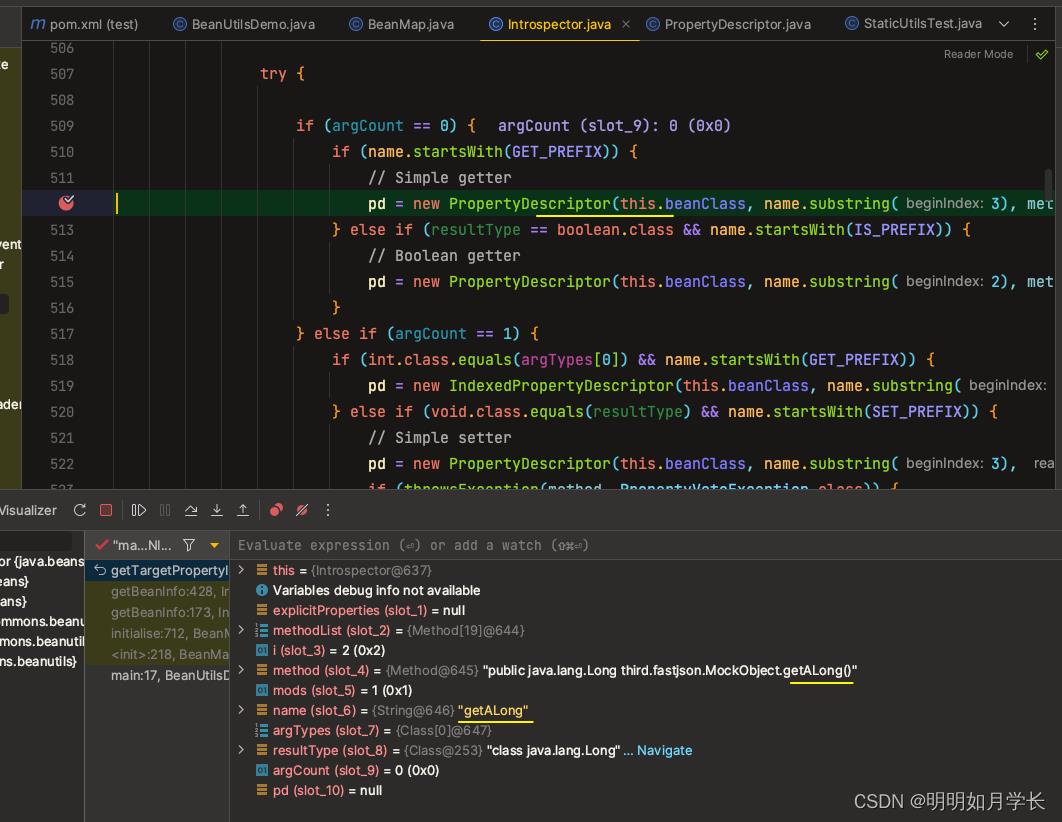
对于无参的以 get 开头的方法名从 index =3 处截取,如 getALong 截取后为 ALong, 如 getADouble 截取后为 ADouble。
然后去构造 PropertyDescriptor:
/**
* Creates <code>PropertyDescriptor</code> for the specified bean
* with the specified name and methods to read/write the property value.
*
* @param bean the type of the target bean
* @param base the base name of the property (the rest of the method name)
* @param read the method used for reading the property value
* @param write the method used for writing the property value
* @exception IntrospectionException if an exception occurs during introspection
*
* @since 1.7
*/
PropertyDescriptor(Class<?> bean, String base, Method read, Method write) throws IntrospectionException
if (bean == null)
throw new IntrospectionException("Target Bean class is null");
setClass0(bean);
setName(Introspector.decapitalize(base));
setReadMethod(read);
setWriteMethod(write);
this.baseName = base;
底层使用 java.beans.Introspector#decapitalize 进行解析:
/**
* Utility method to take a string and convert it to normal Java variable
* name capitalization. This normally means converting the first
* character from upper case to lower case, but in the (unusual) special
* case when there is more than one character and both the first and
* second characters are upper case, we leave it alone.
* <p>
* Thus "FooBah" becomes "fooBah" and "X" becomes "x", but "URL" stays
* as "URL".
*
* @param name The string to be decapitalized.
* @return The decapitalized version of the string.
*/
public static String decapitalize(String name)
if (name == null || name.length() == 0)
return name;
if (name.length() > 1 && Character.isUpperCase(name.charAt(1)) &&
Character.isUpperCase(name.charAt(0)))
return name;
char chars[] = name.toCharArray();
chars[0] = Character.toLowerCase(chars[0]);
return new String(chars);
从代码中我们可以看出
(1) 当 name 的长度 > 1,且第一个字符和第二个字符都大写时,直接返回参数作为PropertyDescriptor name。
(2) 否则将 name 转为首字母小写
这种处理本意是为了不让属性为类似 URL 这种缩略词转为 uRL ,结果“误伤”了我们这种场景。
2.2.2 使用 cglib 的 BeanMap
cglib 依赖
<!-- https://mvnrepository.com/artifact/cglib/cglib -->
<dependency>
<groupId>cglib</groupId>
<artifactId>cglib-nodep</artifactId>
<version>3.2.12</version>
</dependency>
代码示例:
import net.sf.cglib.beans.BeanMap;
import third.fastjson.MockObject;
import java.util.Date;
public class BeanMapDemo
public static void main(String[] args)
MockObject mockObject = new MockObject();
mockObject.setAInteger(1);
mockObject.setALong(2L);
mockObject.setADate(new Date());
mockObject.setADouble(3.4D);
mockObject.setParent(3L);
BeanMap beanMapp = BeanMap.create(mockObject);
System.out.println(beanMapp);
结果展示:

我们发现类型对了,但是属性名依然不对。
关键代码:
net.sf.cglib.core.ReflectUtils#getBeanGetters
底层也会用到 java.beans.Introspector#decapitalize 所以属性名存在一样的问题就不足为奇了。
三、解决办法
3.1 解决方案
解决方案有很多,本文提供一个基于 dubbo的解决方案。
maven 依赖:
<!-- https://mvnrepository.com/artifact/org.apache.dubbo/dubbo -->
<dependency>
<groupId>org.apache.dubbo</groupId>
<artifactId>dubbo</artifactId>
<version>3.0.9</version>
</dependency>
示例代码:
import org.apache.dubbo.common.utils.PojoUtils;
import third.fastjson.MockObject;
import java.util.Date;
public class DubboPojoDemo
public static void main(String[] args)
MockObject mockObject = new MockObject();
mockObject.setAInteger(1);
mockObject.setALong(2L);
mockObject.setADate(new Date());
mockObject.setADouble(3.4D);
mockObject.setParent(3L);
Object generalize = PojoUtils.generalize(mockObject);
System.out.println(generalize);
调试效果:
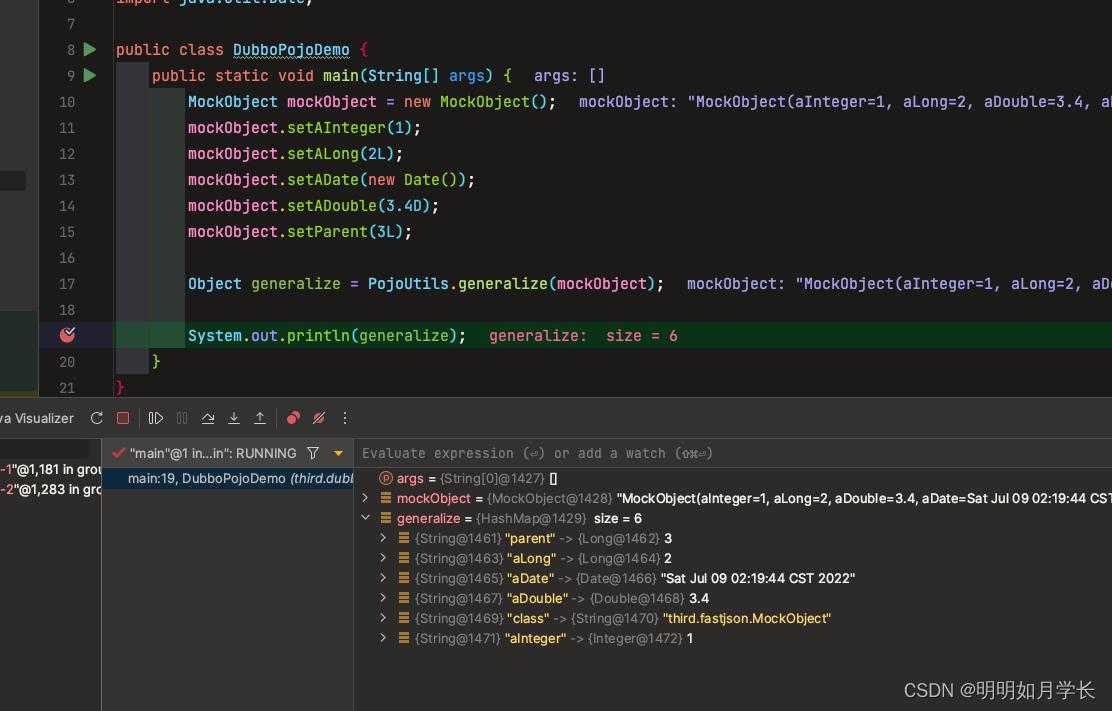 Java Visualizer 效果:
Java Visualizer 效果:
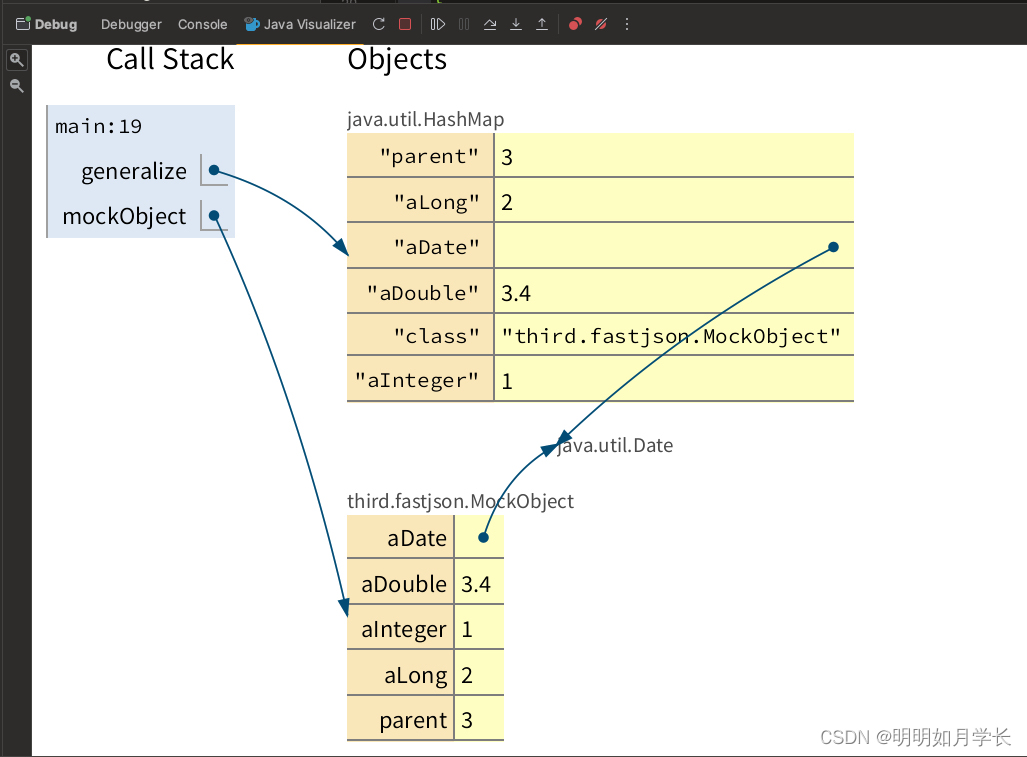
3.2 原理解析
大家可以下载源码来简单研究下。
https://github.com/apache/dubbo
核心代码:
org.apache.dubbo.common.utils.PojoUtils#generalize(java.lang.Object)
public static Object generalize(Object pojo)
eturn generalize(pojo, new IdentityHashMap());
关键代码:
// pojo 待转换的对象
// history 缓存 Map,提高性能
private static Object generalize(Object pojo, Map<Object, Object> history)
if (pojo == null)
return null;
// 枚举直接返回枚举名
if (pojo instanceof Enum<?>)
return ((Enum<?>) pojo).name();
// 枚举数组,返回枚举名数组
if (pojo.getClass().isArray() && Enum.class.isAssignableFrom(pojo.getClass().getComponentType()))
int len = Array.getLength(pojo);
String[] values = new String[len];
for (int i = 0; i < len; i++)
values[i] = ((Enum<?>) Array.get(pojo, i)).name();
return values;
// 基本类型返回 pojo 自身
if (ReflectUtils.isPrimitives(pojo.getClass()))
return pojo;
// Class 返回 name
if (pojo instanceof Class)
return ((Class) pojo).getName();
Object o = history.get(pojo);
if (o != null)
return o;
history.put(pojo, pojo);
// 数组类型,递归
if (pojo.getClass().isArray())
int len = Array.getLength(pojo);
Object[] dest = new Object[len];
history.put(pojo, dest);
for (int i = 0; i < len; i++)
Object obj = Array.get(pojo, i);
dest[i] = generalize(obj, history);
return dest;
// 集合类型递归
if (pojo instanceof Collection<?>)
Collection<Object> src = (Collection<Object>) pojo;
int len = src.size();
Collection<Object> dest = (pojo instanceof List<?>) ? new ArrayList<Object>(len) : new HashSet<Object>(len);
history.put(pojo, dest);
for (Object obj : src)
dest.add(generalize(obj, history));
return dest;
// Map 类型,直接 对 key 和 value 处理
if (pojo instanceof Map<?, ?>)
Map<Object, Object> src = (Map<Object, Object>) pojo;
Map<Object, Object> dest 以上是关于巨坑系列:Java Bean 转 Map 的那些坑的主要内容,如果未能解决你的问题,请参考以下文章